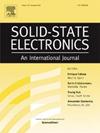GatedNN: An accurate deep learning-based parameter extraction for BSIM-CMG
IF 1.4
4区 物理与天体物理
Q3 ENGINEERING, ELECTRICAL & ELECTRONIC
引用次数: 0
Abstract
An enhanced deep learning (DL) -based parameter extraction method for transistor compact models, named GatedNN, is introduced. GatedNN achieves significant accuracy improvements over existing DL-based parameter extraction techniques. The innovation lies in incorporating neural network (NN) with gating mechanism and compact model-aware techniques: model parameter importance analysis and model quality check. The GatedNN uses gates to resolve optimization conflicts among model parameters by controlling gradient descent during training. The importance analysis focuses on optimizing more crucial parameters that contribute to the current curve. The model quality check cleans the training data fed to the GatedNN and ensures the robustness of the NN output. Evaluated on the BSIM-CMG model with measured FinFET data, the proposed approach demonstrates a substantial 69% error reduction compared to recently DL-based parameter extractor. Furthermore, the scalability and mathematical robustness of the generated model are tested. The proposed GatedNN also provides insights into model parameters and device characteristics, aiding in understanding and adjusting for desired characteristics. We believe the developed method can advance the development of DL-based parameter extraction.
基于深度学习的BSIM-CMG精确参数提取方法
介绍了一种基于增强深度学习(DL)的晶体管紧凑模型参数提取方法——GatedNN。GatedNN在现有的基于dl的参数提取技术上实现了显著的精度提高。该方法的创新之处在于将神经网络与门控机制和紧凑的模型感知技术相结合:模型参数重要性分析和模型质量检查。GatedNN在训练过程中通过控制梯度下降来解决模型参数之间的优化冲突。重要性分析侧重于优化对当前曲线有贡献的更关键的参数。模型质量检查对输入到GatedNN的训练数据进行清洗,保证神经网络输出的鲁棒性。用测量的FinFET数据对BSIM-CMG模型进行了评估,与最近基于dl的参数提取器相比,该方法的误差降低了69%。最后,对所生成模型的可扩展性和数学鲁棒性进行了验证。所提出的GatedNN还提供了对模型参数和设备特性的见解,有助于理解和调整所需的特性。我们相信所开发的方法可以推动基于dl的参数提取的发展。
本文章由计算机程序翻译,如有差异,请以英文原文为准。
求助全文
约1分钟内获得全文
求助全文
来源期刊

Solid-state Electronics
物理-工程:电子与电气
CiteScore
3.00
自引率
5.90%
发文量
212
审稿时长
3 months
期刊介绍:
It is the aim of this journal to bring together in one publication outstanding papers reporting new and original work in the following areas: (1) applications of solid-state physics and technology to electronics and optoelectronics, including theory and device design; (2) optical, electrical, morphological characterization techniques and parameter extraction of devices; (3) fabrication of semiconductor devices, and also device-related materials growth, measurement and evaluation; (4) the physics and modeling of submicron and nanoscale microelectronic and optoelectronic devices, including processing, measurement, and performance evaluation; (5) applications of numerical methods to the modeling and simulation of solid-state devices and processes; and (6) nanoscale electronic and optoelectronic devices, photovoltaics, sensors, and MEMS based on semiconductor and alternative electronic materials; (7) synthesis and electrooptical properties of materials for novel devices.
 求助内容:
求助内容: 应助结果提醒方式:
应助结果提醒方式:


